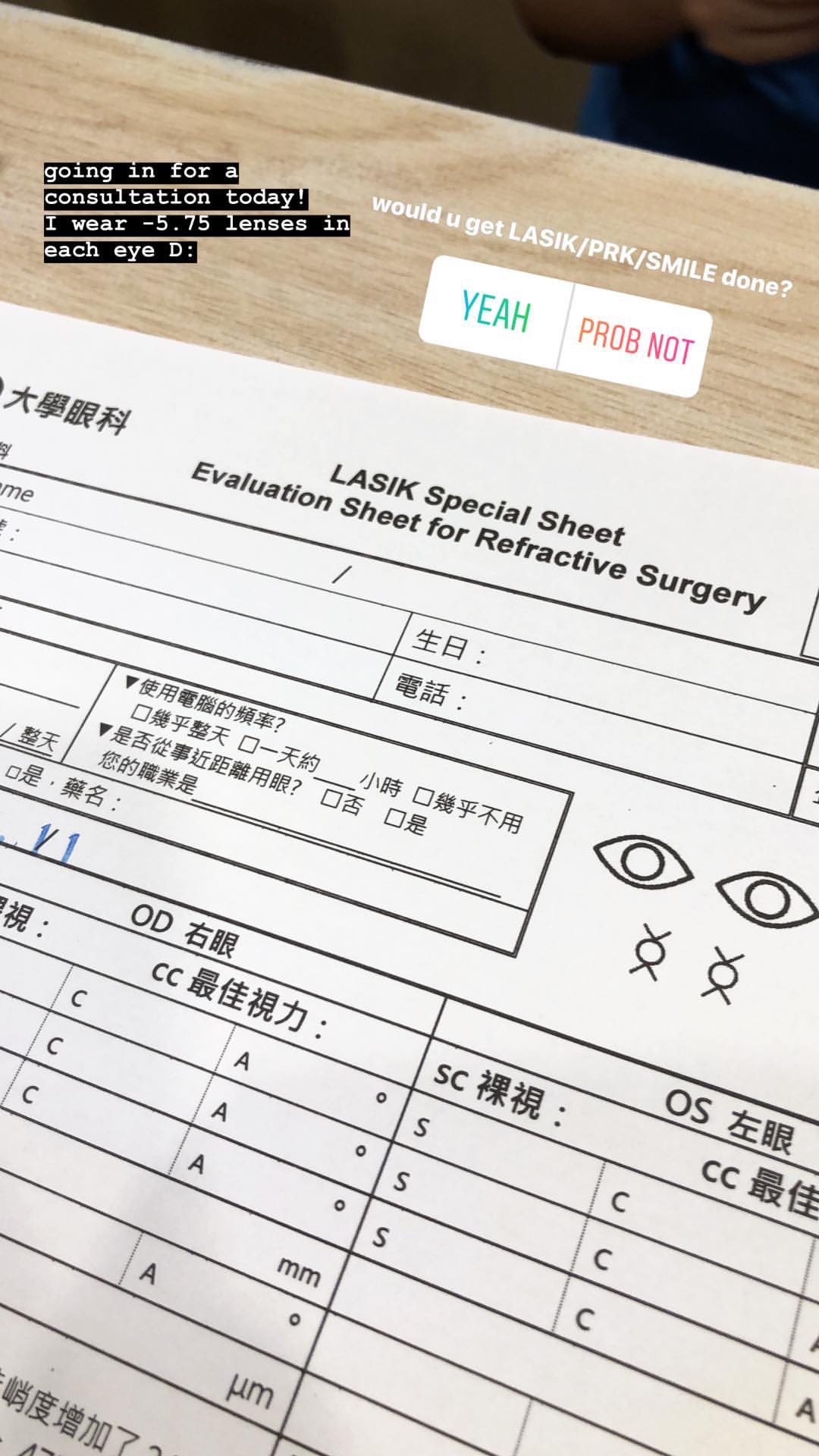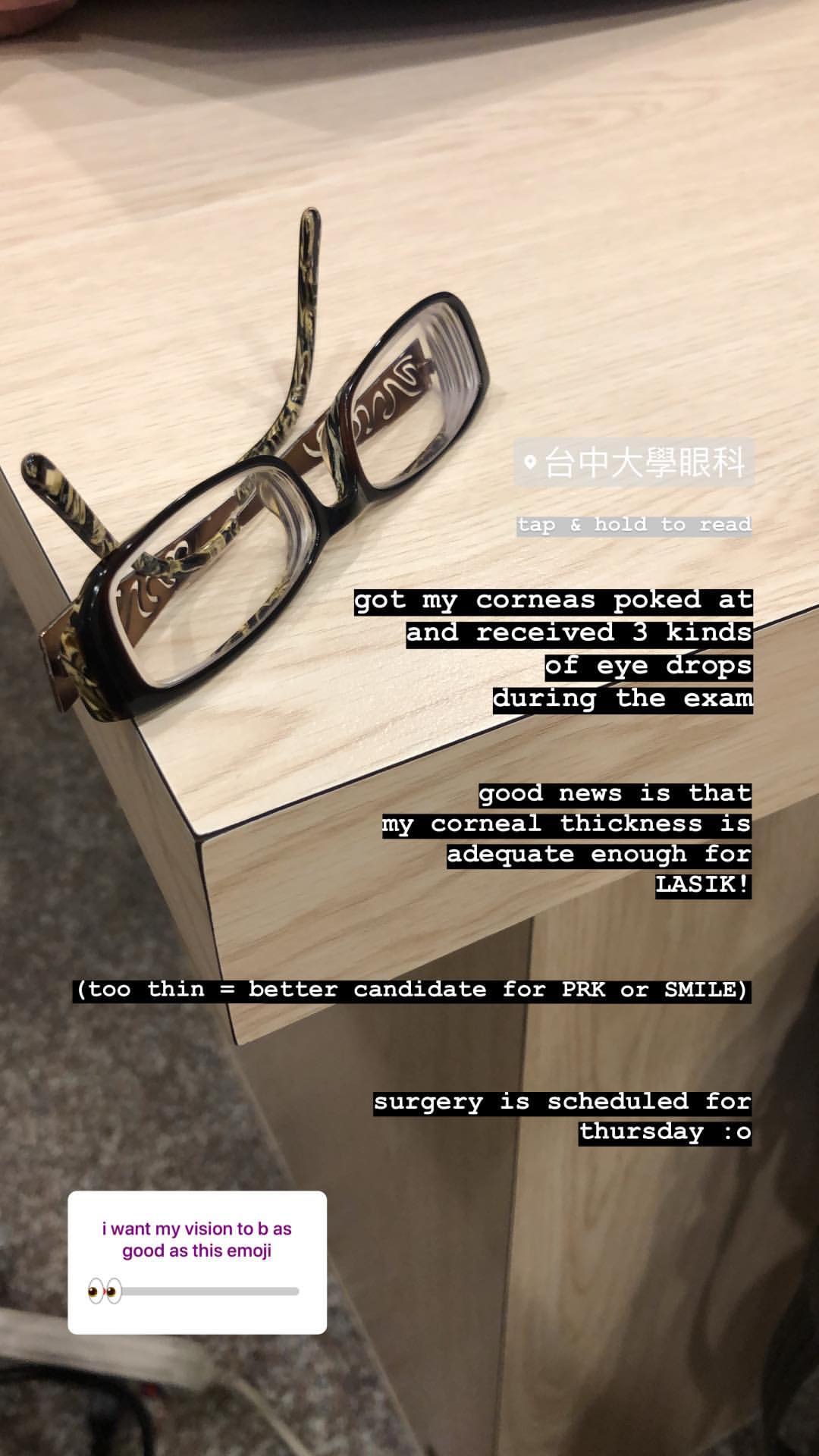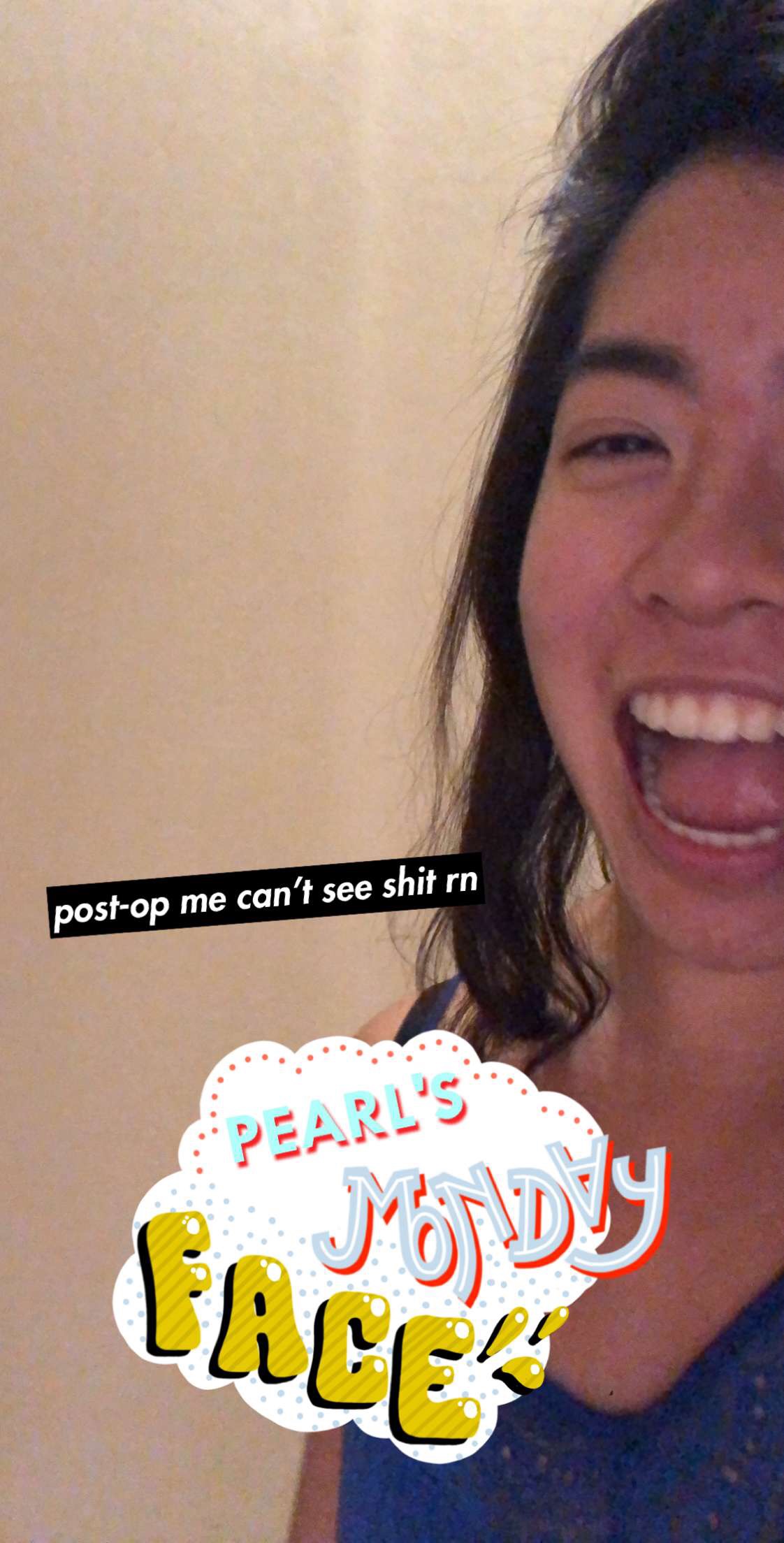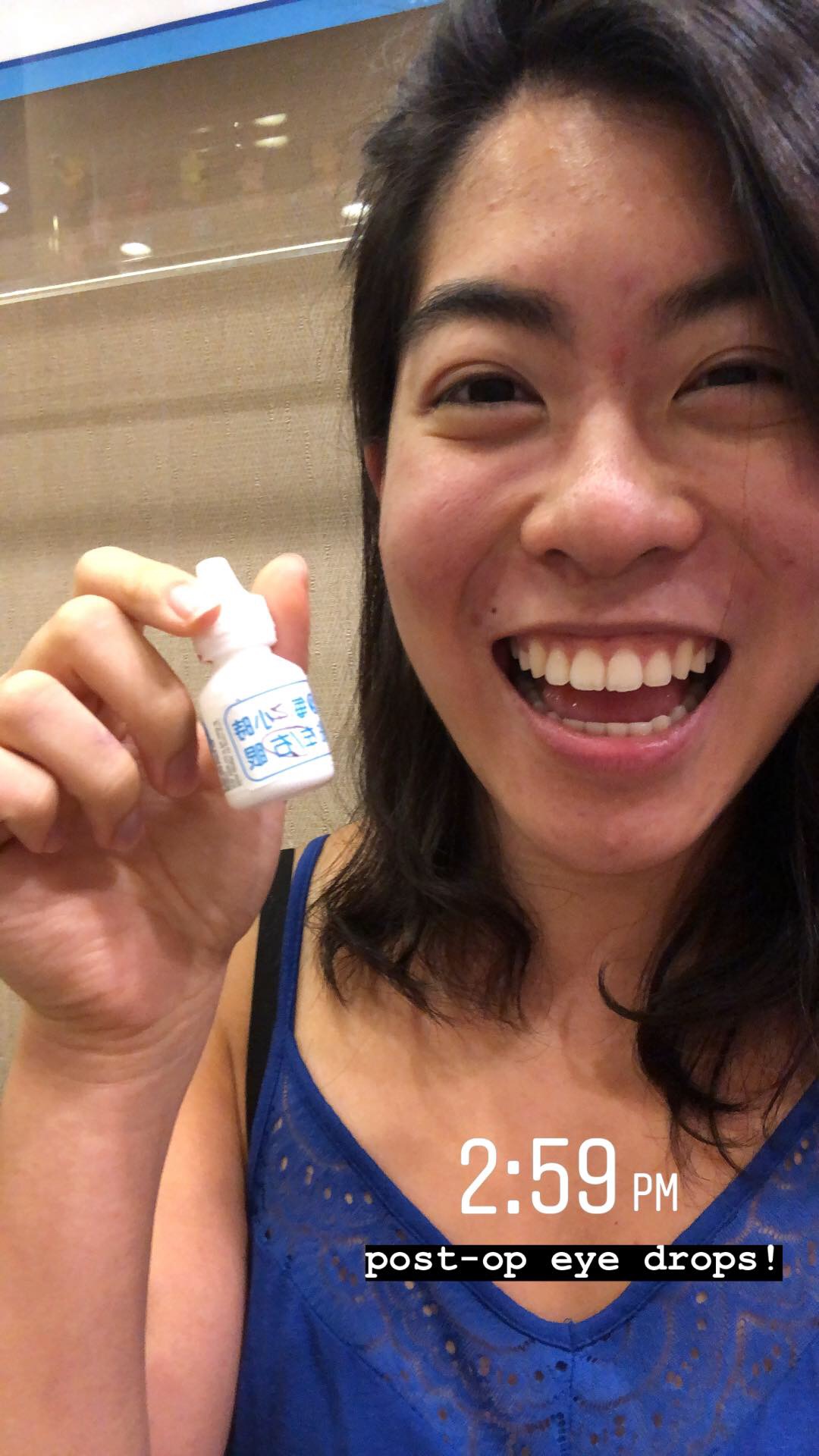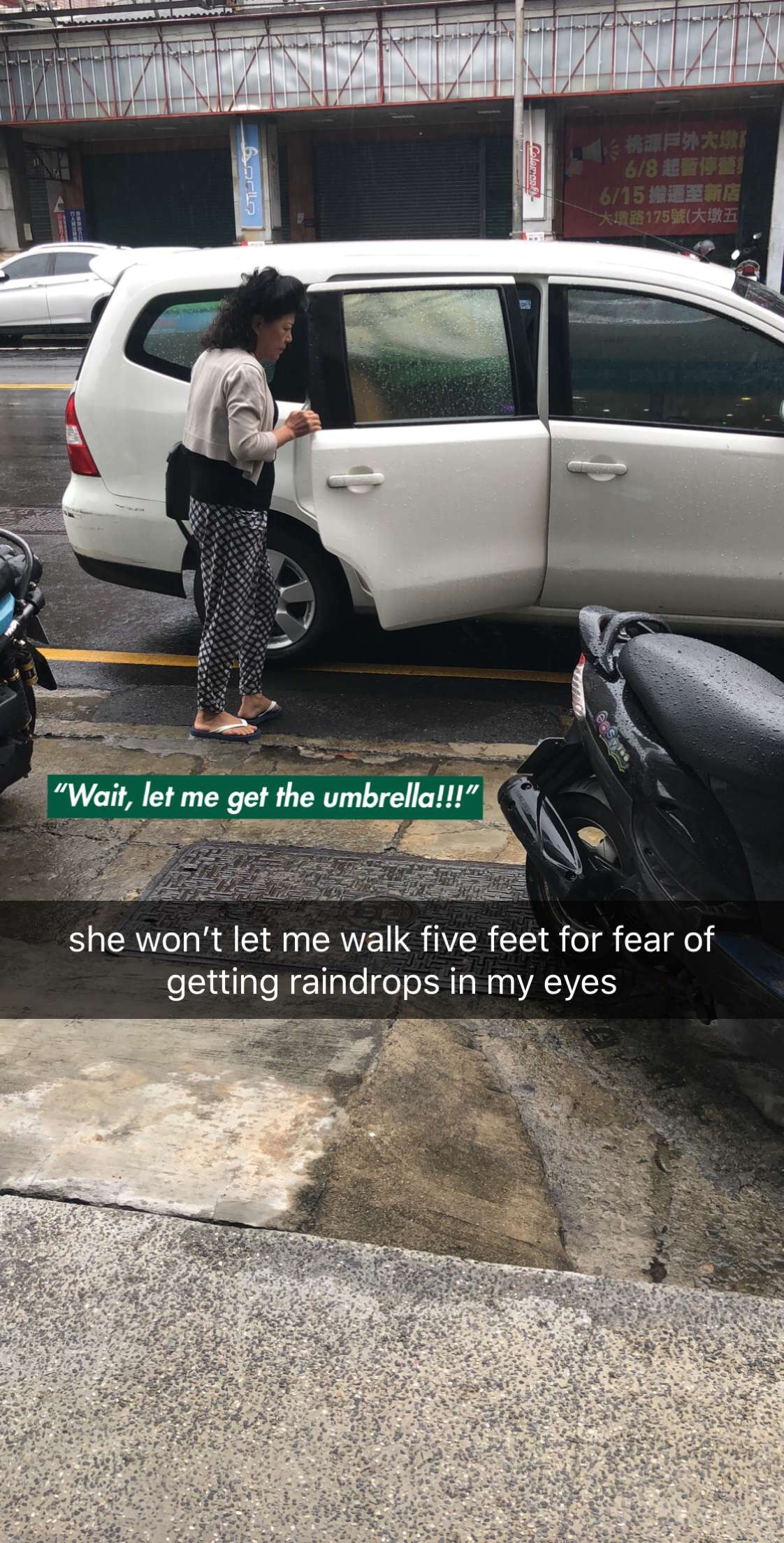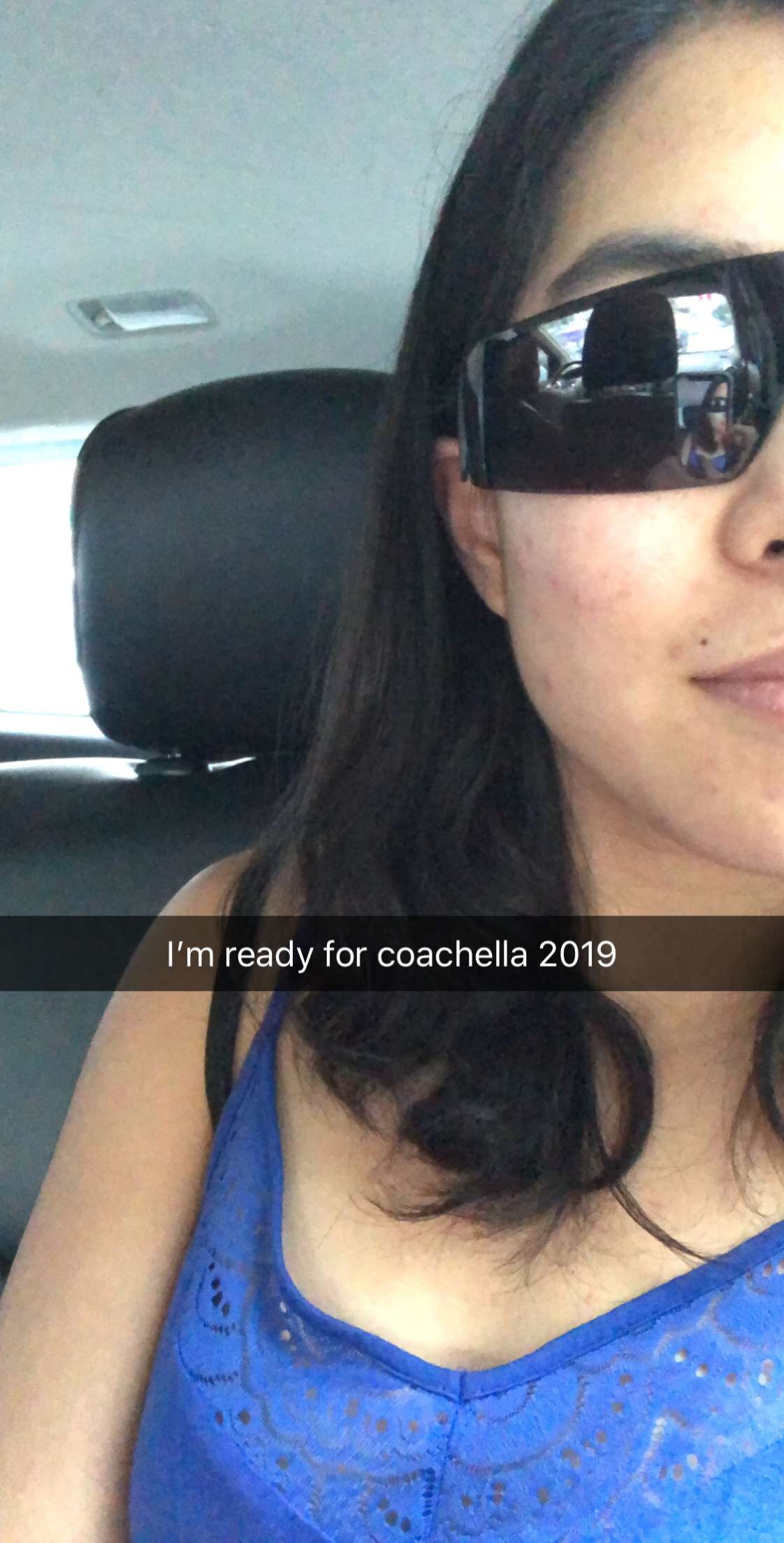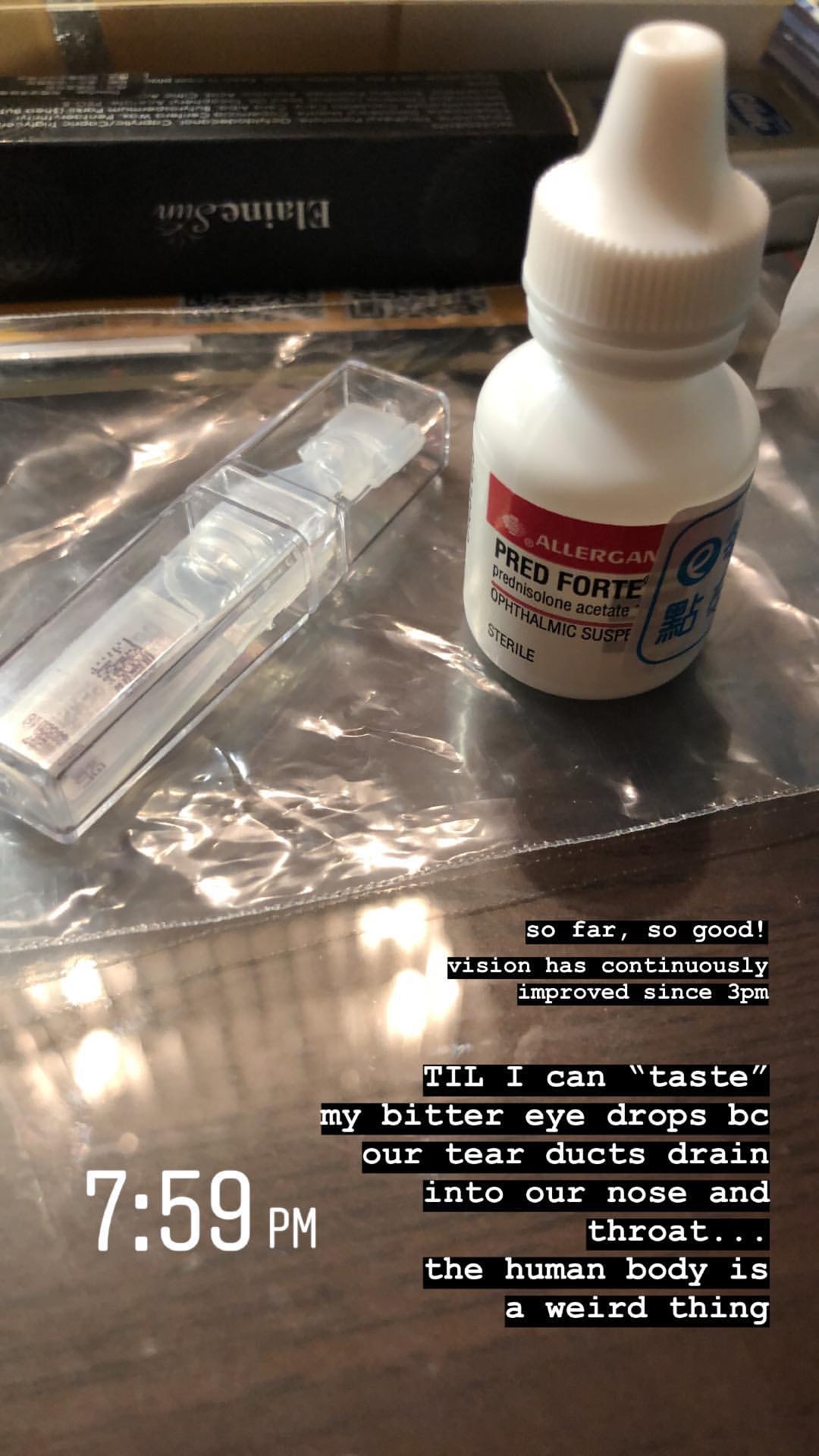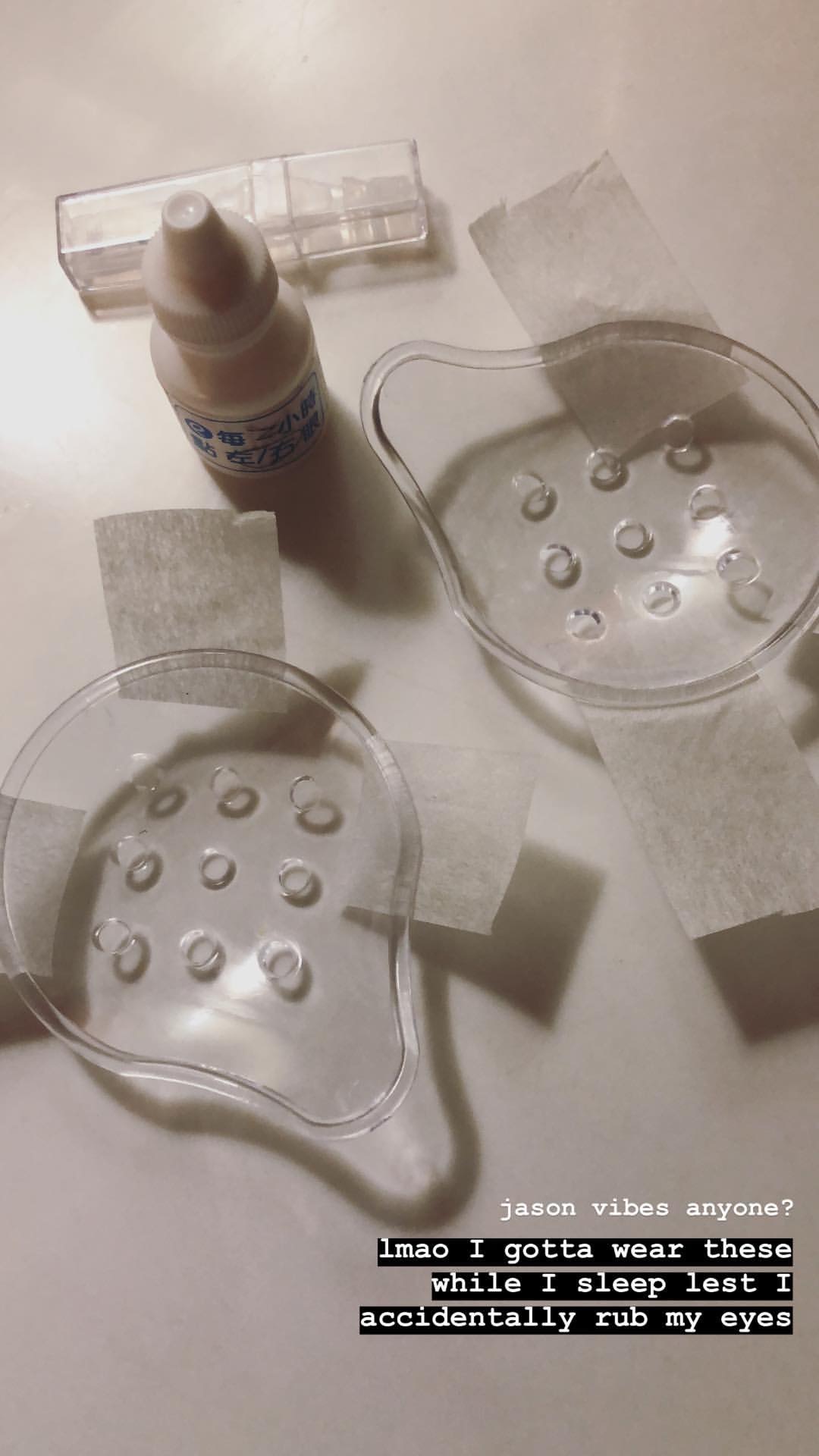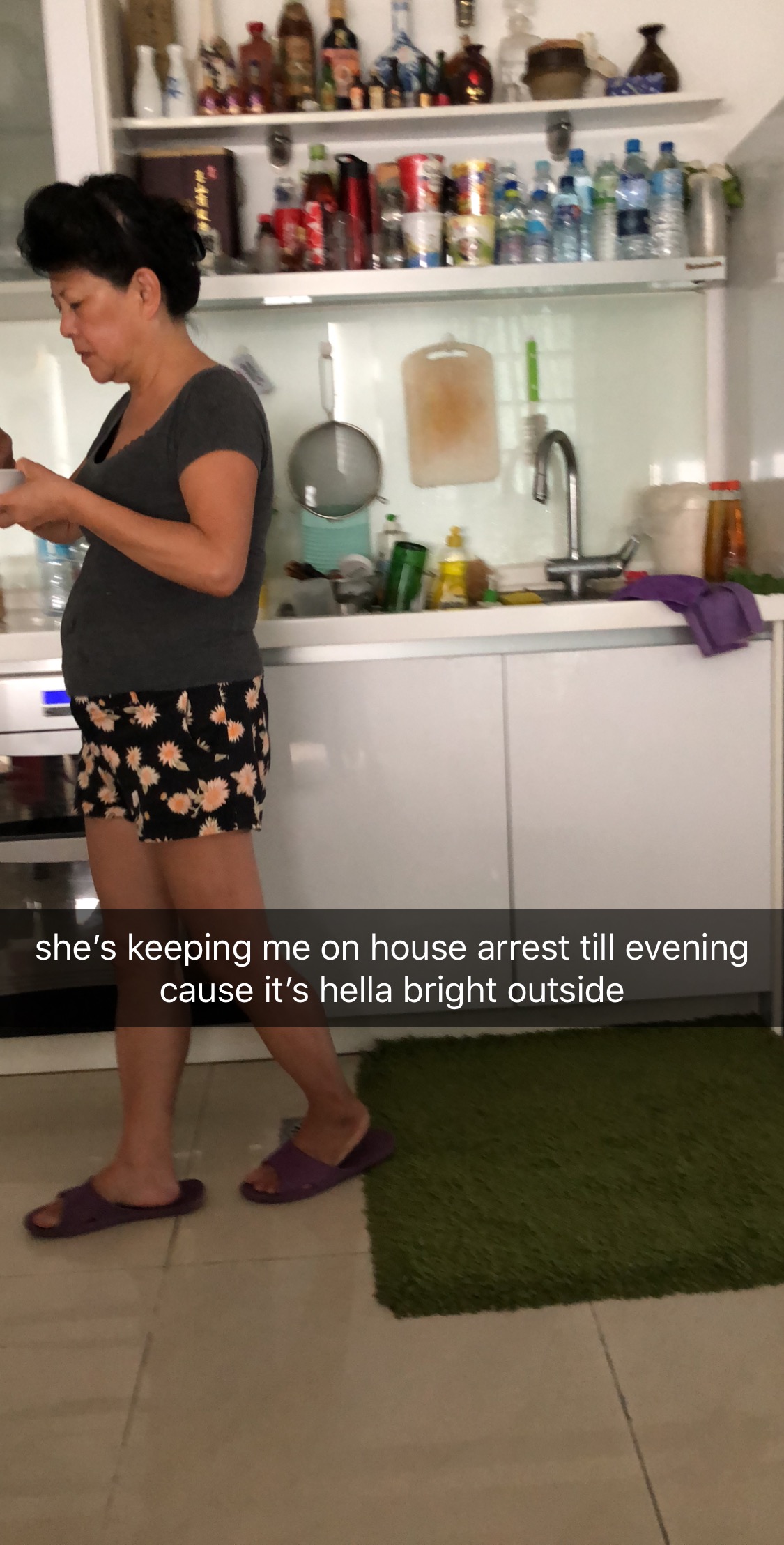What It's Like to Get LASIK
New eyes who dis?
Ya girl got LASIK done over the summer! I am currently a month and a half post-operation. My surgery was done at 大學眼科 in my mother's hometown of Taichung (aka Taizhong if you go by modern Hanyu Pinying romanization), and my eye doc/surgeon was 蘇國豪. I won't lie and say that the entire experience was painless (the surgery itself was 100% pain-free because I had local anesthesia, but I had irritating dry-eye immediately post-op), but I would absolutely undergo the minor discomfort again for my new vision. It's like I was seeing my life in JPG before and now everything is in RAW. For real, guys. It's hard to imagine having such bad vision if you've never needed glasses or contacts, but I was pretty blind. Couldn't read the time on my lock screen if you held my phone at arm's length away from me. BUT NOW I CAN, without visual aids!!! *Johnny Nash’s I Can See Clearly Now plays in the background*
Format of today's post:
play-by-play of my experience, from consultation to surgery to post-op care
FAQ on common questions I've received about my procedure
Why I Got LASIK
I'm 22 and I've worn glasses since the first grade, and contacts (Acuvue Oasys) since the 6th grade. My lens prescription was -6.00 myopia (nearsightedness), PLUS mild astigmatism, in each eye. I disliked wearing my glasses because they constantly slid down my nose and didn’t fit my face quite right. And have you ever tried to enjoy a hot bowl of noodle soup with glasses on? You can't, because it's steaming and fogging up your lenses. Your options are either to wait for the soup to cool down or take off your glasses and finish your meal half-blind #firstworldproblems. The cons of contacts are similarly innocuous, but boy, fall asleep with ‘em in and you'll wake up with uncomfortable, dry, half-blind vision.
The plastic waste adds up, too, regardless of whether you wear dailies, biweekly, or monthly contacts. That was a big reason I wanted to get LASIK done—no more huge plastic bottles of lens solution or used lenses that end up in landfills. Plus, every box of lens solution comes with a new lens case, and I’ve acquired more of them than I know what to do with. There are only so many cases I can fill with travel-size dollops of moisturizer (reduce, reuse, repurpose!) before I lose track of which case actually has my lenses..But I digress. A great piece of news is that Bausch & Lomb has partnered with Terracycle to collect your blister packs and used contact lenses for free. Go to their site to print a shipping label and chuck all your old lenses/packaging into a cardboard box to mail in. All brands accepted!
TIMELINE
CONSULTATION // SATURDAY, 03/18/18
My consultation consisted of a series of non-invasive eye measurements via machines and some bright lights. The optometrist used a machine that blew puffs of air into my eyes to check for glaucoma, mapped them with infrared light, and had me do a regular "read the letters" vision test. The most important factor that was measured was my corneal thickness, as surgery would ablate, or flatten, my corneas to refocus the light on my retina correctly. The worse your vision is, the more your corneas need to be reshaped, and the clinic won’t perform LASIK if a candidate’s corneal thickness post-operation is less than their 350 um threshold; they’ll undergo PRK or SMILE instead. The good news was that after all the calculations, I was deemed eligible for LASIK. The doctor provided four tiers of treatment options, ranging from NT49000 to 109000 (about US$1600-3600) for both eyes. The differences in price were due to technology used to 1) create the corneal flap— microkeratome vs IntraLase (aka bladeless)— and 2) perform the actual correction—topography-guided vs Wavefront-guided or Wavefront-optimized. (David Weekly explains the differences in layman’s terms quite well.) I chose the second tier for NT69000 ($2300) but was upgraded to the NT89000 ($2900) for free, because my mom is a smooth talking magician. Not exactly sure which tier which used what technology, though I did sign my name on two sets of Intralase speculums…don’t be uninformed like me, guys. I didn’t feel too strongly because my mom did most of the discussing in Chinese and I trusted her and she was paying for it in the end.
This is your vision, so do your research, consider your options carefully, and choose the option that’s most suitable for you. Even though Wavefront LASIK may be more expensive and it seems logical to shell out for your health, you might not even be eligible for it if your corneas are highly irregular, as measured by an aberrometer.
DAY before Surgery // Sunday, 08/14/18
I washed my hair the night before my appointment so I could maximize the time after my surgery before my next wash. Orders were to avoid getting water into my eyes for a week to avoid bacterial infection, which doesn’t mean I avoided the shower for seven days; I got these giant Post-It notes from the clinic to stick on my forehead to shield my eyes from stray water droplets. I usually wash my face in the shower, but switched to washing my face over the sink so I could see what I was doing and “wipe” off the cleanser suds with wet hands, rather than splash my entire face clean like in those Neutrogena commercials.
DAY OF SURGERY // MONDAY, 08/13/18
I arrived at the clinic at 8:30am for my appointment. An assistant gave me an anti-anxiety pill, put some drops in my eyes (presumably antibiotic solution), went over pre- and post-op instructions, and gave me an aftercare kit. I got two sets of hermetically sealed speculums, which would be used to hold my eyes open, on which to write my name. People seem to hate speculums as much as they despise the word “moist” but they’re a necessary evil. I was given scrubs to wear over my clothes, elastic shoe covers, a hair net, and then sat in a waiting room while three people ahead of me got their surgeries. The same assistant swabbed iodine over the top half of my face and gave me more eye drops (numbing, this time). I was instructed not to touch my eyes or face thereafter, lest I transfer bacteria from my hands.
When it was my turn, I was led into the operating room—sparsely furnished and kept quite cool, likely to inhibit bacteria growth. The surgeon greeted me and I lied down on what looked like a typical dentist's chair. The first half of the operation was to create the flaps in my corneas. My left eye was operated on first. The surgeon taped my eyelashes back, put more eyedrops in, set the speculum in place, covered the rest of my face with a paper shield, and instructed me to look at the center of the double LED ring light over my face while he turned on the femtolaser that created microscopic air bubbles in my cornea. During the procedure I drifted my head to the side almost imperceptibly; I was told to tilt my chin down and refocus my terribly-blurry vision on the the green LED above me: "If the LED seems wobbly, it's not the light that's moving, it's you. So stop wavering." I breathed through my mouth the entire time because I read on Reddit that some people could smell the laser zapping their eyeballs and I was already freaked out enough. I’m making this sound scarier than it is. Should you choose to get LASIK, you’ll be more mentally prepared than I am thanks to this post. You’re welcome.
Once the first laser finished, the eyelash tape and speculum were removed, my right eye was operated on, and I was led back to the waiting room to let the air bubbles inflate and naturally create the flap. This is an unusual description, but when I looked into a mirror, it looked like someone had dripped a metallic gel pen onto my eyeballs—the air bubbles gave my pupils a glossy, anime look (enjoying my stream of consciousness?). I waited about ten minutes before I went back to the op-room for the second part of my procedure.
For the second half of my surgery, I laid in the same chair with a different laser machine swung over my head—one that would reshape my corneas. Again, my left eye was done first. More eye drops, more blurry vision while trying to focus on an LED dot. When the surgeon brushed my eye flap to the side, my vision got substantially worse and I was worried I couldn't tell where the dot was, but he gave me directions when he saw my eyes drift off-center. "You're looking too far to the left, focus on the green dot!" When my left eye was done getting lasered, the surgeon used what looked like a paintbrush to move the flap back into place and smooth it out. More eyedrops, then my right eye, and I was out of the operating room within 10 minutes.
It was around 3pm when I checked the clock after my surgery. My vision was clear but hazy at the same time; I could read the signs on the doors in front of me, but my peripheral vision was blurry. The doctor did a flashlight check-up to make sure there were no "wrinkles" and sent me home. Although the general consensus on Reddit was that I should rest my irritated eyes and take a nap, the doctor told me not to sleep right away for fear of excessive eye movement that could displace the cornea flaps. So for two hours, before my same-day check-up at 5pm, my mom and I killed time by getting a late lunch at my favorite traditional restaraunt.
By the time I returned to the clinic at 5pm, I was quite miserable because my eyes stung and bothered. The doctor said I was having a strong, but expected, inflammatory reaction , and I was told to use the Optive drops in my kit—glycerin & carboxymethylcellulose sodium to the rescue🙏. For the rest of the day, I used the glycerin drops whenever I felt the stinging return (about every 1.5 hours), preservative-free saline drops to keep my eyes moist (about every hour), and Pred Forte steroid drops (every 2 hours). Part of my aftercare included 1) wearing these UV-light blocking googles that look they were taken from a woodshop and 2) taping these ridiculous acrylic eye cups to my face before bed to keep me from accidentally rubbing my eyes while I slept.
TWO DAYS POST-OP // WEDNESDAY, 08/15/18
Another 2 minute check-up at the clinic to make sure my vision hasn't declined. At this point, my vision is as clear as when I wore contacts. Maybe even a bit better, because I've worn the same prescription for the past three years even though my vision's probably gotten worse during then. I've been using the preservative-free drops every 1-2 hours, more often if I'm outside where there's a breeze or if I've been staring at a screen. Steroid drops four times a day. My eyes don't sting anymore, so the doctor says I can discontinue the Optive drops. I am now a pro at self-administering eye drops with one hand.
five DAYS POST-OP // Saturday, 08/18/18
While not recommended, I started going to bed without the eye cups because they were disruptive to my sleep and I was sure I wouldn't accidentally rub my eyes. Still using the saline and steroid drops.
1 week POST-OP // Monday, 08/20/18
Check up #3 at the clinic. Healing seems to be on schedule. Switched from preservative-free saline solution to a green bottle of Refresh lubricant drops that I use 3-4 times a day. It's wonderful to have perfect vision once I wake up. Crystal clear during the day, though I experience glare/halos around bright lights at night. This is to be expected, as my pupils dilate in the dark and my still-healing corneal flap refracts light a bit suboptimally. London Vision Clinic says this is normal, so I’ll start worrying at the three-month mark if I’m still experiencing glare in low-light environments.
1 month POST-OP // THU, 09/13/18
Eye drop use reduced to once a week. Still experiencing slight glare in low-light, no biggie. At least I only notice when I go for runs at night or walk outside in the evenings. Most indoor situations are bright enough for my vision to remain unaffected.
1.5 months POST-OP // SAT, 09/29/18
Same, same. I barely reach for my eye drops now, though I always keep the the bottle handy because the outdoor temperature is dropping and dry, heated indoor environments might give me problems.
2021 UPDATE
Finally used my vision insurance benefits to get my free annual eye exam in the States and good news, the eye doc said my eyes healed perfectly, as far as they could tell. Turns out the glare that has persisted over the years is due to a bit of residual astigmatism (main power: 0, 0; cylinder: -0.5, -1). The doc said it’s nothing to worry about as I technically have 20/20 vision and I don’t drive at night so glasses are optional, not an absolute need.
FAQ
Does LASIK EYE SURGERY hurt?
The surgery itself is 100% pain-free because you’ll get local anesthesia in the form of numbing eye drops. I didn’t feel a thing when the lasers were on, nor when the doctor moved my corneal flap in and out of the way. Afterward though, when the numbing drops wore off, my eyes stung and it felt like I had bad allergies. Optive drops from my aftercare kit instantly relieved my discomfort—glycerin & carboxymethylcellulose sodium to the rescue🙏—and I used them whenever I felt the stinging return (about every 1.5 hours). By the time I woke up the next day, I didn’t have any more stinging; just continued using preservative-free saline drops to keep my eyes moist (about every hour), and Pred Forte steroid drops (every 2 hours).
How much does LASIK cost?
Our doctor in Taiwan provided four tiers of treatment options, ranging from NT49000 to 109000 (about US$1600-3600) for both eyes. The differences in price were due to technology used to 1) create the corneal flap— microkeratome vs IntraLase (aka bladeless)— and 2) perform the actual correction—topography-guided vs Wavefront-guided or Wavefront-optimized. (David Weekly explains the differences in layman’s terms quite well.) I chose the second tier for NT69000 ($2300) but was upgraded to the NT89000 ($2900) for free, because my mom is a smooth talking magician. Not exactly sure which tier which used what technology, though I did sign my name on two sets of Intralase speculums…don’t be uninformed like me, guys. I didn’t feel too strongly because my mom did most of the discussing in Chinese and I trusted her and she was paying for it in the end.
How do I know if I’m eligible for LASIK?
Most clinics will do a free consultation and let you know if your eyes are most suited for LASIK, PRK, or SMILE, and if LASIK, which kind (traditional topography-guided or either of the Wavefront technology assisted ones).
What’s the difference between LASIK, PRK, and SMILE?
Let me Google that for you. In short, LASIK uses a femtolaser to create a corneal flap and an excimer laser perform the correction. PRK uses a blade to scrape and reshape your cornea, so while the procedure has a slower recovery time, it’s recommended for those with thin corneas and those involved in contact sports because there’s no risk of flap-related complications. SMILE uses a femtolaser to create an incision that’s much smaller than the cut created during LASIK and then a tiny piece of the cornea is manually removed. Both PRK and SMILE are recommended for those with thin corneas who aren’t eligible for LASIK.
Why did you get it done in Taiwan?
Cheaper to get it done in Taiwan than in the States. I was in Taiwan for three weeks for the summer and knew I could go for weekly checkups. Now that I’m back in the States and don’t have the same guy to check my eyes every month, it’s a bit unideal of a situation, but the price difference was worth it IMO. Most clinics in the US will charge $2000+ per eye. I paid around that price for both.
Is there a minimum age restriction?
From Diamond Vision Clinic: “Most providers won't perform LASIK on those under 18 because eyes tend to keep changing into early adulthood. But laser eye surgery has been performed on children with severe vision problems. These are outliers to most cases. The most common age for LASIK, in fact, falls between the ages of 20 and 40.” I got it done at age 22, I have a few friends around my age who’ve done it in the past two years, and my godmother, who’s in her late sixties, got LASIK done when she was in her mid-twenties, and is doing a-okay right now.
